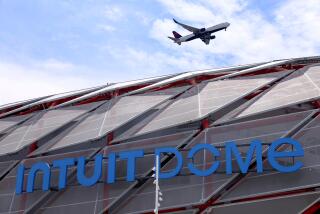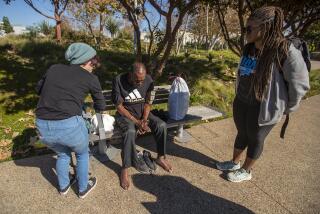Plan Would Limit Alcohol Licenses : Regulation: The Planning Commission wants to slow the proliferation of places that serve liquor. Critics say it would hurt the city and is a tool to curb development.
- Share via
SANTA MONICA — It’s almost enough to drive bar owner Lou Moench to plunder his own stock.
“The Planning Commission wants to gut the public life of the city,” grumbled the proprietor of the Father’s Office bar on Montana Avenue. He was referring to a proposed citywide alcohol policy aimed at slowing the proliferation of liquor licenses.
But commission Chairman Ralph Mechur rejects the idea that his panel is trying to stop anyone from having fun. “We’re trying to be a responsible body,” he said, ticking off a list of alcohol-related social ills.
If enacted, the policy would limit the location of liquor stores, nightclubs and bars.
It would also make it more difficult and expensive for small restaurants to obtain permits to serve alcohol, including beer and wine.
Although the proposal focuses on alcohol, it has opened an argument on the broader issues of growth and development.
Some observers say anti-growth advocates have seized on the alcohol proposal as a tool for putting the brakes on development.
“They’ve beaten the traffic issue to death and now they’ve found another one,” Planning Commissioner Paul Rosenstein said. “It sounds as if (anti-growth forces) think Santa Monica should be a small village in Oregon.”
Paul Berlant of the city planning staff said the policy evolved out of concern for alcohol abuse and safety, then gained momentum as slow-growth backers piled on.
He cautioned that the city needs “to be careful not to kill restaurants.”
The city Finance Department said that of the $15.8 million the city collected in sales tax revenue last year, $2.3 million came from restaurants--$1 million from restaurants that serve alcohol.
“What is getting lost is the freedom of the residents of this city to enjoy their own city,” said Russ Barnard, owner of Tavern on Main and developer of Sinbad’s, a proposed bar and restaurant on Santa Monica Pier.
The city has granted licenses freely in recent years, principally at Third Street Promenade. Businesses on the outdoor pedestrian mall hold 53 of the city’s 323 alcohol permits, which include liquor stores.
With a population of 87,000--which does not take into account tourists and non-resident employees--Santa Monica has 13.2 outlets for on-site alcohol consumption for every 10,000 residents, the third-highest ratio in Los Angeles County. Beverly Hills and West Hollywood have 21.9 outlets per 10,000 residents.
Those who defend tighter restrictions say keeping the number of alcohol permits in check is simply common sense.
“When we try to control traffic, nobody accuses me of trying to outlaw personal automobiles,” said Planning Commissioner Jennifer Polhemus, one of the staunchest supporters of increased alcohol regulation.
“In a city that’s so enlightened about other issues, we’re in a state of denial about alcohol,” Councilman Kelly Olsen said at a recent meeting.
But others wonder if the proposal isn’t a solution in search of a problem.
Foes of the plan note that the city already limits alcohol outlets on Main Street to two per block.
And, they say, the city bans promenade patrons from ordering alcohol outdoors after 11:30 p.m. and promotes rigorous designated-driver and alcohol-server training programs, drawing guarded praise from the police.
“For the number of alcohol establishments, I’d expect to have a lot more problems,” said Sgt. Gary Gallinot, who heads promenade police security.
Gil Grey, an inspector for the state Alcoholic Beverage Commission, said Santa Monica as a whole doesn’t present more of a problem than other communities in the county’s coastal corridor.
Alcohol- and drug-related accidents have steadily decreased in Santa Monica during the past decade from 243 in 1981 to 99 in the first nine months of 1991, Police Department records show.
And even as the number of alcohol licenses was increasing, drunk-driving arrests were decreasing, from 1,151 in 1989 to 449 for 1991 as of Oct. 20.
In light of such evidence, Bruce Cameron of the Pier Restoration Commission board of directors seemed perplexed about the movement sweeping Santa Monica that some have labeled neo-Prohibitionist.
“I’ve sat here night after night listening to discussions about alcohol policy, and I have yet to hear any clear definition of what the problem is,” Cameron told the Planning Commission last week.
Advocates of the license-limitation policy say the problems associated with alcohol are numerous, and include such hidden costs as domestic abuse, alcoholism, fetal alcohol syndrome and higher enforcement costs in addition to the more obvious concerns of drunk driving, sales to minors and disorderly conduct.
The Police Department’s accident numbers, they add, are misleading.
Stephanie Barbanell of the Westside Alcohol Policy Coalition noted that the downtown area--with a concentration of 160 licenses--experienced a crime rate almost 60% higher than the rest of the city.
Citing ABC regulations, she said that the level of crime relative to the rest of the city is high enough to justify withholding any additional licenses, a point confirmed by police.
“The (ABC) rules are there,” Sgt. Bill Brucker said. “She’s right. The question is whether the city wants to do anything about it.”
Said Barbanell: “In areas that are unduly concentrated (with licenses), we have to say enough is enough.”
To a large extent, the proposal would do exactly that. Any new bar, nightclub or liquor store would be required to be located at least 1,000 feet from any other alcohol outlet, school, store, park, church, playground or hospital and 100 feet from residences.
Hours would be limited and operators would be required to submit an employee training plan for alcohol servers.
Furthermore, small restaurants with 49 or fewer seats could be required to obtain a conditional-use permit, which typically costs $2,000 and takes some months to obtain and would enable the Planning Commission to attach various restrictions to the license.
Other parts of the proposal call for:
* A temporary permit for events at which alcohol is served.
* Restaurants to be located at least 500 feet from any other outlet serving alcohol.
* Restaurants to close their bars at midnight.
More to Read
Sign up for Essential California
The most important California stories and recommendations in your inbox every morning.
You may occasionally receive promotional content from the Los Angeles Times.













